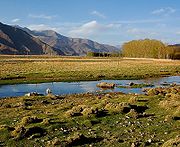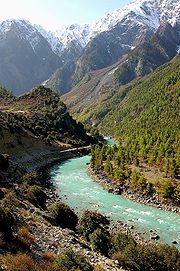
Nyang River
Encyclopedia


Tibet
Tibet is a plateau region in Asia, north-east of the Himalayas. It is the traditional homeland of the Tibetan people as well as some other ethnic groups such as Monpas, Qiang, and Lhobas, and is now also inhabited by considerable numbers of Han and Hui people...
and the longest tributary
Tributary
A tributary or affluent is a stream or river that flows into a main stem river or a lake. A tributary does not flow directly into a sea or ocean...
of the Yarlung Tsangpo river.
The Nyang has a length of 307.5 km and originates at 5,000 meters above the sea level from the Cuomuliangla, west of the Mila Mountain. The river joins the Yarlung Tsangpo in Cemeng, Nyingchi
Nyingchi Prefecture
Nyingchi Prefecture is a prefecture in southwestern Tibet Autonomous Region in western China. The Chinese government claims South Tibet, which is currently governed by India, as part of the prefecture....
, 2,580 meters below its source. With an average flow of 538 cubic meters per minute, it has an aquatic power potential of 2.08 million kilowatts. Its largest tributary is the Ba River
Ba River (China)
The Ba River is a river in Tibet and the largest tributary of the Nyang River. It is the source of the Dadie Waterfall.-External links:*...
. It flows past the town of Bayi where it is crossed by the Bayi Zanchen bridge.
According to a Chinese government website aimed at investors, the Niyang River valley has an area of 24,800 km², including 175,700 mǔ (117 km²) of cultivated land
Arable land
In geography and agriculture, arable land is land that can be used for growing crops. It includes all land under temporary crops , temporary meadows for mowing or pasture, land under market and kitchen gardens and land temporarily fallow...
, 209,800 mǔ (140 km²) of usable wasteland, 24.75 million mǔ (16,500 km²) of forestry
Forestry
Forestry is the interdisciplinary profession embracing the science, art, and craft of creating, managing, using, and conserving forests and associated resources in a sustainable manner to meet desired goals, needs, and values for human benefit. Forestry is practiced in plantations and natural stands...
land, and 12 million mǔ (8,000 km²) of usable grassland
Grassland
Grasslands are areas where the vegetation is dominated by grasses and other herbaceous plants . However, sedge and rush families can also be found. Grasslands occur naturally on all continents except Antarctica...
. It is also reported to contain 1,500 kinds of wild animals and plants, 310,000,000 million m³ of wood reserves and 18 million kw of hydroenergy
Hydroelectricity
Hydroelectricity is the term referring to electricity generated by hydropower; the production of electrical power through the use of the gravitational force of falling or flowing water. It is the most widely used form of renewable energy...
resources.

